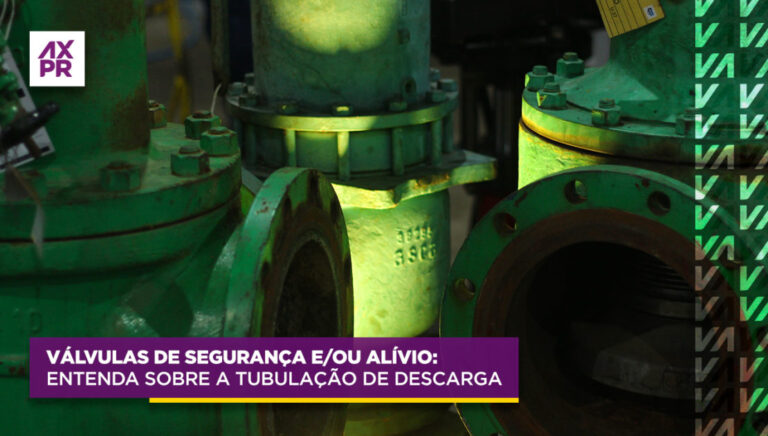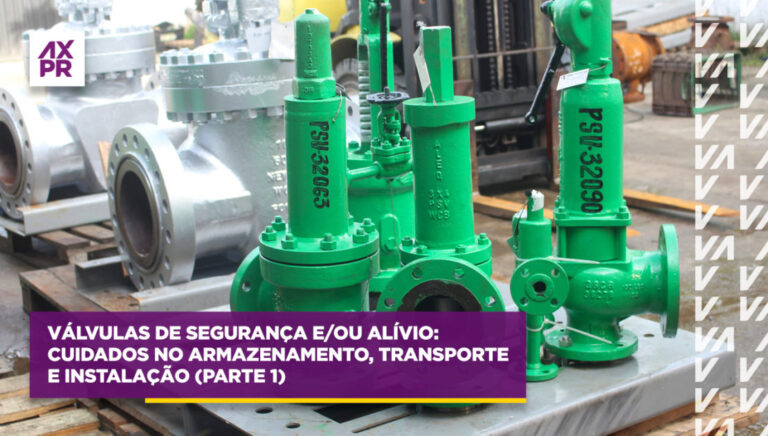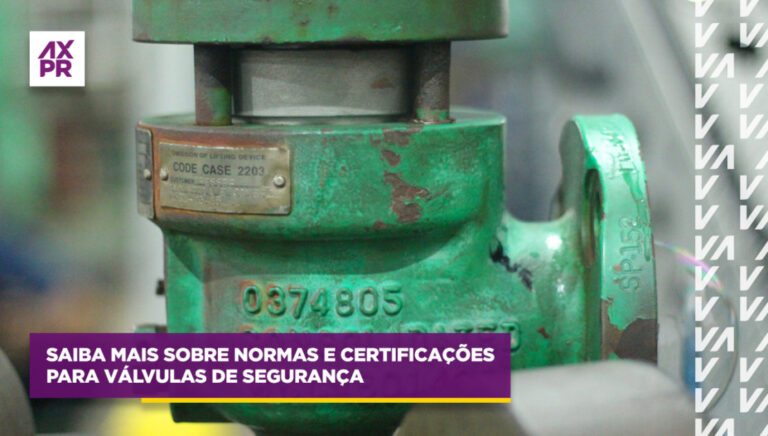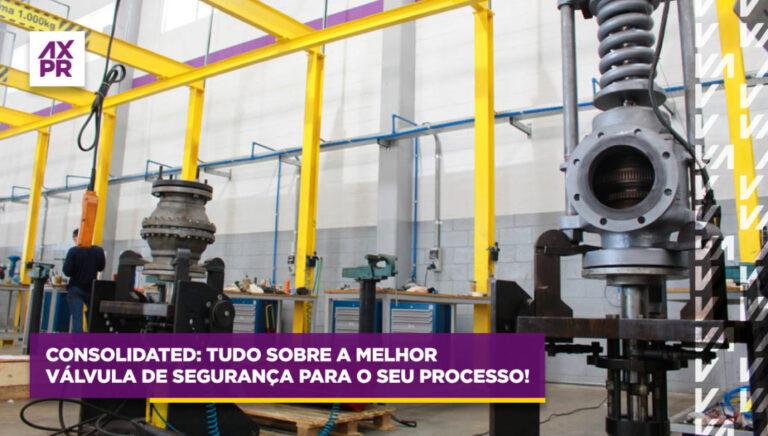Check out this complete guide on safety valves and understand the concepts, standards, and procedures to follow.
There are several types of valves on the market, including safety valves, also known as PSV valves, which are devices that relieve pressure from the systems in which they are installed.
If your goal is to learn more about this valve, its function, and the standards and procedures that govern this category, know that you are in the right place, as in this article, we will cover:
- What is a PSV valve and its function;
- Difference between a safety valve and a relief valve;
- How storage, transportation, and installation should be;
- What should be analyzed in the design and installation of the inlet and outlet piping;
- Standards and certifications;
- Sizing a safety valve (PSV).
Ready? Let's get started!
What is a safety valve and its function?
PSV valves (Pressure Safety Valve) are devices for pressure relief used in industrial equipment, such as vessels or boilers, whose operating pressure is higher than atmospheric pressure.
The primary function of a safety valve is the protection of lives and properties, and as the name suggests, fulfill the role of promoting safety by preventing large pressure increases that can cause damage to equipment or even explosions.
In this way, protection occurs when the valve is capable of discharging a certain flow rate, which must be predicted in its sizing, considering the worst expected condition for the occurrence of pressure elevation. This flow rate must be sufficient to reduce the pressure of a system to a safe level.
Every boiler or pressure vessel requires the installation of safety and/or relief valves for its protection. Safety valves and relief valves are two types of devices whose operation is based on the use of static inlet pressure to actuate the device.
But what is the main difference between safety valves (PSV) and relief valves (PRV)?
Known as PRV,Pressure Relief Valve, the relief valve is an automatic pressure-limiting device characterized by a progressive and proportional opening to overpressure.
However, the safety valve (PSV) is an automatic pressure-limiting device, also characterized by its instantaneous opening, known as "POP," which occurs when the process pressure reaches the defined opening pressure for valve actuation.
If you want to know more about these two valves, we recommend accessing the article we published on our blog on the subject. Just click here and enjoy this complete content.
Care to be taken in the storage, transportation, and installation of PSV valves
This is a very important point to be addressed because it is of no use to have a correctly designed installation if due care is not taken during storage, transportation, and handling.
Check out the main precautions that should be followed at this moment:
- Safety valves must always be stored in the vertical position;
- Care in handling during disassembly – and during transportation to the test bench in the workshop – should also be careful and always in the vertical position;
- They should be stored in a safe place, free of dust and moisture;
- Avoid the entry of foreign materials into the valve inlet (or between guide components) as this can compromise the sealing and operation of the valve;
- Every safety and/or relief valve must be transported to the installation site, preferably, moments before.
If you want to know more details about how this whole process should be, know that we also wrote an article about it, and you can access it by clicking here.
Just as ignoring these procedures can cause problems in the operation of PSV valves, there is also damage that can occur during installation related to the inlet piping, and that's what we'll see next.
Inlet Piping: How to install it correctly?
Did you know that 75% of all operational problems that occur with safety valves (and/or relief valves) are directly related to incorrect installation? Among them are the damages caused to the inlet piping.
Thinking about helping you at this moment, we have separated some guidelines that must be respected during the project and that will help you succeed in the installation of your valve, check it out:
- The internal diameter must be equal to or greater than the valve inlet connection;
- The length of this piping should be 5 times its nominal diameter or 200 mm;
- The limited pressure drop must be 3% of the set pressure for valves protecting pressure vessels;
- It must be calculated 2% of the set pressure or 2 psi, whichever is greater (for valves protecting boilers);
- • Where allowed, use only full-bore blocking valves, gate valves, or ball valves, for example. But beware, in boilers, the use of blocking valves or any accessory between the boiler and the valve is expressly prohibited.
As you could see, this is a process that must be designed meticulously for the total operation of a PSV valve. But besides that, there are also other precautions that must be taken after installation. Do you know them? If your answer is negative, rest assured because we have a complete content on this subject here on our blog, let's check it out? Click here and enjoy the reading!
Understand about the discharge (outlet) piping
Just like the inlet piping, the discharge piping needs attention in its design. This component, when operated with steam and non-toxic gases, disposes of hot water above 100°C into the atmosphere (open discharge system), and all of this must occur as short and direct as possible.
For this, it is necessary to pay attention to the following requirements:
- Use the correct support, as heavy and poorly supported piping can cause misalignment of internal valve components, as well as leaks in operating pressure;
- The maximum backpressure must be 10% of the set pressure for a conventional valve with closed and sealed bonnet and cap, or 20% for a conventional valve with an open bonnet (exposed spring);
- Pipelines that run vertically and then project at an angle of approximately 45°, discharging directly into the atmosphere, should be avoided;
- If the discharge point is cut at 45°, it can reduce reaction forces when the valve opens;
- When the discharge piping is installed horizontally, it is always recommended that it has a slope of 1 millimeter for every meter of length.
In addition to these, there are other additional recommendations, and you can check them out in the article we wrote in partnership with Artur Cardozo Mathias. Check out this content by clicking here!
Standards and certifications for PSV valves
For safety valves to fulfill the goal of ensuring safe operation, there are several standards and certifications that govern their operation, and that's what we'll talk about now.
The first of these was developed by ASME (American Society of Mechanical Engineers), which defines all technical standards for the manufacture of boilers, pressure vessels, and auxiliary equipment , describing rules and procedures for their design, sizing, inspection, maintenance, and installation.
When it comes to PSV valves, the standard is divided as follows:
- Section I (Boiler Construction Code) – It is focused on the technical standards to be employed in the construction of boilers, including their safety valves;
- Section VIII (Non-fired pressure vessels) – Refers to the rules for the manufacture of pressure vessels and piping, including technical procedures for safety valves operating with steam, liquids, and gases. This section has a gigantic range of action.
There is also a national regulation for this process: NR-13.This standard evaluates technical definitions, inspection periods, calibration, and various technical aspects, as well as the figure of the qualified professional (PH) who is responsible for supervising the equipment.
Remember that it is extremely important that you are aware of these standards because non-compliance with them can have various legal consequences. And if you want to know more about this subject, know that we also have an article on our blog about it. Just click here to access.
Sizing PSV Valves: What needs to be analyzed?
Like all the topics mentioned earlier, it is important to emphasize that correct sizing of a safety valve is essential for its correct operation. Check out what needs to be analyzed at this moment:
- Type of fluid and physical state (liquid, gaseous, or two-phase);
- Mass or volume of fluid flow required by the process;
- Pressure and temperature of the fluid;
- Type and value of backpressure;
- Equipment construction code (ASME), as mentioned in the previous topic;
- For liquids: density and viscosity at the flow temperature;
- For gases: molecular weight or specific gravity, temperature, specific heat ratio (Cp/Cv) under relief conditions, and compressibility factor "Z".
Count on Axpr to acquire the ideal safety valve
Axpr, in addition to following all the requirements of NR-13, is a company that has the GTC (Green Tag Centers) seal granted by Baker Hughes, which ensures a highly qualified team to indicate the ideal valve for your operation, as well as performing services and maintenance following all technical standards required by the norms.
Want to know more about how we can help make your operation safer? Contact our team of specialists by clicking here!







